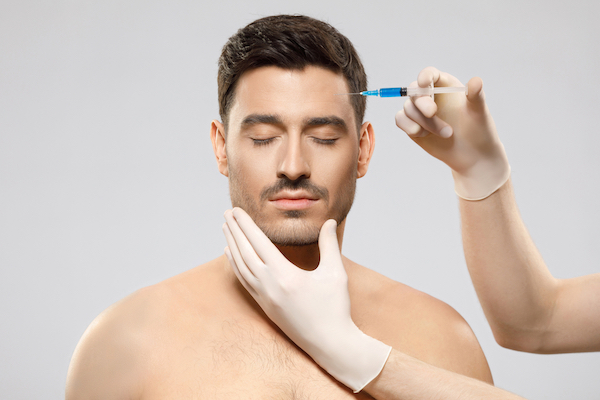
As you age, your skin changes and these changes can be dramatic in men as well as women. Although Botox and dermal fillers have been typically marketed toward women, we know that men benefit from these treatments just as much.
Non-surgical facial treatments have key differences depending on the area, gender, and the desired result of the person being treated. With the exception of men who seek to feminise their facial features, men who want dermal fillers or Botox typically want to achieve different aesthetic outcomes than women.
The overall goal when performing aesthetic non-surgical cosmetic treatments on female patients is to erase lines and wrinkles and enhance facial features such as lips and cheekbones. Men, however, tend to want to define their jawline and subtly reduce lines and wrinkles rather than make them disappear altogether. This is why it is critical to adapt how Botox and dermal fillers are performed to produce masculine results when treating male patients.
Before we take a more in-depth look at how Botox and dermal fillers can be used and the difference in the end result, let’s first explain how these two injectable cosmetic treatments are distinguished.
Botox is the name often used when referring to muscle relaxers, sometimes called neuromodulators or neurotoxins made with purified botulinum toxin. Obtained from bacteria, botulinum toxin has been used for over two decades to treat neurological disorders and other medical conditions. By temporarily blocking nerve signals in the area injected, the muscles become paralysed.
Dermal fillers can be made from numerous substances derived from natural or synthetic sources. The first facial dermal filler was approved in 1981, and there are now four types of materials approved by the FDA for use in dermal fillers. Unlike Botox, dermal fillers do not paralyse muscles but fill in and smooth out wrinkles, which are essentially creases in your skin.
The male face must be approached differently than the female face to avoid feminising certain features. Where Botox is injected on the forehead will affect how the eyebrows sit. The general aim with women is to create an arched eyebrow that sits slightly higher than the brow ridge. On the male face, the eyebrow should be straighter and lower down on the brow ridge.
Another factor is the male hairline tends to be higher and may be receding. Men also typically want a more subtle result, as a totally smooth, wrinkle-free face can remove character and look very unnatural. This is why it is essential that the clinician knows how to modify their technique for men when injecting Botox.

Wrinkles and lines can be caused by muscle movement or a breakdown of collagen. Botox can only be used to smooth out wrinkles that are a result of muscles contracting and relaxing, referred to as dynamic wrinkles.
The most common areas of the face that are treated with Botox are the following:
• Upper Face — Wrinkles between the brows and horizontal lines on the forehead.
• Eyes — Fine lines and wrinkles at the outer corners of your eyes, often referred to as crow’s feet.
• Lower Face — Marionette lines extend from the side of the nose and curve around the outer corners of the mouth, often referred to as laughter lines.
Botox injections treat wrinkles in these areas by paralysing the muscle movements that create the creases in the skin. When the muscles no longer move, the wrinkles can be reduced or even erased. With deeper wrinkles, especially if you are over 50, dermal fillers may be required. Dermal fillers are ideal for softening wrinkles without freezing all muscle movement in the face.
According to the NHS, Botox is a low-risk cosmetic treatment when performed by an appropriately qualified practitioner.
The side effects of Botox are normally only temporary, as the body absorbs Botox over time.
Common risks of Botox include:
• Drooping of eyelids or eyebrows
• Rash or itching skin
• Bruising, swelling, and redness
• Eye redness and irritation
• Headaches, nausea, and flu-like symptoms (lasting around 24 hours).
Rare risks of Botox include:
• Difficulty swallowing, speaking or breathing
• Gallbladder dysfunction
• Vision disturbance
• Antibody-induced failure, Botox failing occurs in less than 1% of people.
Botox is one of the safest types of non-invasive cosmetic anti-ageing treatments available. However, you may not be suitable for Botox if you have multiple sclerosis or a neuromuscular disorder (NMD). When Botox cannot be safely used, dermal fillers might be recommended as an alternative treatment.
Botox injections can sting and feel uncomfortable; however, most people do not find the procedure painful.
It takes between 3 -5 days for this to work and up to two weeks.
Botox is not a permanent treatment. Repeated treatments are necessary for continued wrinkle-reducing effects.
Most people find that the muscle-relaxing effect of Botox lasts for 3 to 4 months.
Dermal fillers can be used to reduce deeper set lines and wrinkles, known as static wrinkles, and for facial contouring or non-surgical rhinoplasty, often referred to as a liquid nose job. Treating men with dermal fillers can masculinise or feminise facial features. Using appropriate types of filler and adapting injection techniques to alter and enhance the proportions of the male face is key for a natural look.
Dermal fillers are very versatile and can be used in all areas of the face. Common treatment areas include:
• Upper Face — Deep set wrinkles between the brows and horizontal lines on the forehead.
• Eyes — The fine lines and wrinkles that sit close to your eyes’ outer corners, often called crow’s feet and the hollows (tear troughs) under the eyes.
• Lower Face — Marionette lines that run down the lower portion of the face from the edge of the nostrils to around the mouth, often called laughter lines.
• Mouth — Lip filler can increase the volume and definition of the upper and lower lip.
• Nose — reshape the nose with a liquid rhinoplasty.
• Scars — Fill in and reduce the appearance of scars and acne scarring.
Dermal fillers can perform many functions and dramatically change your appearance. Advancements in techniques and dermal filler options allow clinicians to use larger volumes safely. Consequently, dermal fillers now offer an alternative option to plastic surgery procedures such as facelifts, rhinoplasty, and facial implants.
There are various types of FDA-approved dermal fillers available, the most common include:
• Calcium hydroxylapatite (CaHA) is a mineral-like natural compound found in bones and was initially used for reconstructive surgery.
Lasts for between 6 to 12 months.
Brand names include Radiesse.
• Hyaluronic acid (HA) is found in soft connective tissues and certain fluids and is also used to treat arthritis. Due to its long safety record, rare side effects, and complications, HA is one of the most popular types of dermal fillers.
Lasts around 12 to 18 months.
Brand names include Juvederm, Restylane, and Perlane.
• Polylactic acid is a synthetic substance used in sutures for over 40 years.
Lasts for around two years.
Brand names include Sculptra.
• Polymethyl-methacrylate microspheres (PMMA) is a synthetic substance used in surgical implants for years.
Lasts for around five years.
Brand names include Bellafill.
The risks and complications associated with dermal fillers vary depending on the substance. Hyaluronic acid (HA) is our preferred dermal filler because it has a very low risk of complications.
Common risks of Dermal Fillers include:
• Skin rash and itching
• Bruising, bleeding, swelling, and redness
• Asymmetry or lumps.
Rare risks of Dermal Fillers include:
• Allergic reaction
• Nerve damage and numbness
• Necrosis (death of skin cells)
• Infection
• Scarring.
Not all dermal fillers can be dissolved, so we only use Hyaluronic acid (HA), a dissolvable filler.
Anaesthetic cream is applied before treatment, or a dental block can be used in the lips. Most people say that although dermal fillers can sting, they are not painful.
The results are typically immediate.
Silicone is the only filler that may be considered permanent, but due to safety concerns and high complication rates, it is not approved for use in the UK or FDA approved.
Botox and fillers may be used in conjunction with each other in one treatment. To reduce the possibility of minor complications such as swelling, bruising and infection, we advise:
• Don’t drink wine, especially red wine
• Avoid anti-inflammatory painkillers such as Ibuprofen and Aspirin
• Avoid Vitamin E and fish oil or omega-3s
• Try not to eat foods that contain garlic.
• Do not consume alcohol
• Wash your face with a gentle cleanser or soap
• Do not use moisturiser, skincare, or sun protection products
• Don’t apply aftershave to your face.
• Don’t rub or massage the treated areas
• Don’t do any strenuous activities or exercise for 24 hours
• Avoid facial cleansers, skincare, and sun protection products for 24 hours
• Wait a minimum of eight hours before you lie down.
If you feel like your fine lines and wrinkles are more noticeable, or you want to enhance your facial features, then Botox and dermal fillers can provide a fast and simple solution.
If you want to look younger and fresher or change your facial contours without plastic surgery, our aesthetic treatment specialists are here to answer any queries about dermal fillers. Simply book a free no-obligation consultation to discuss a non-invasive cosmetic procedure at our Harley Street clinic in Central London, and we’ll help you discover the treatment option that is best for you.







